“Global Immersive In-Vehicle Entertainment Market to reach a market value of 11.6 Billion by 2031 growing at a CAGR of 27.1%”
The Global Immersive In-Vehicle Entertainment Market size is expected to reach $11.6 billion by 2031, rising at a market growth of 27.1% CAGR during the forecast period.
Passengers can interact with and investigate the content from all angles with 360-degree videos, which provide a panoramic view. This technology provides a unique and engaging way to watch videos, making it popular among passengers who seek immersive experience. The promising revenue share of this segment reflects the growing interest and adoption of 360-degree videos in vehicles, driven by advancements in video capture and playback technology. This segment’s potential for growth is significant as more consumers look for innovative and engaging entertainment options during their travels. Thus, the 360-degree video segment held 11% revenue share in the immersive in-vehicle entertainment market in 2023.
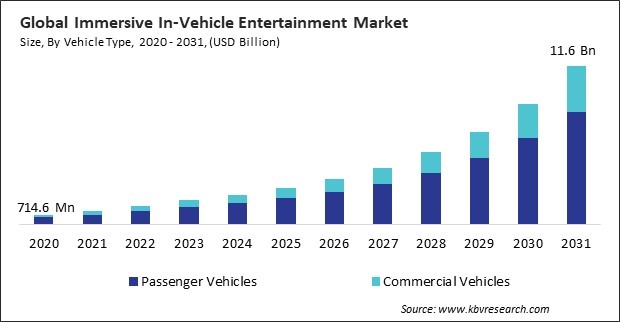
The major strategies followed by the market participants are Product Launches as the key developmental strategy to keep pace with the changing demands of end users. For instance, October, 2024, Panasonic Holdings Corporation unveiled a new auto framing feature, available in the AW-UE160 PTZ camera, which utilizes auto tracking, image recognition, and human body detection for precise framing. The Advanced Auto Framing plug-in for the Media Production Suite, launching in Q2 2025, enhances multi-camera setups and supports facial recognition for optimal framing. Additionally, In July, 2024, LG Electronics, Inc. unveiled Disney+ into its Automotive Content Platform (ACP) powered by webOS, enhancing in-car entertainment options. The LG ACP also features popular apps like Netflix, YouTube, and TikTok, requiring a subscription to Disney.
Based on the Analysis presented in the KBV Cardinal matrix; Apple, Inc. and Google LLC are the forerunners in the Immersive In-Vehicle Entertainment Market. Companies such as Tesla, Inc., Harman International Industries, Inc., and Qualcomm Incorporated are some of the key innovators in Immersive In-Vehicle Entertainment Market. In October, 2023, Google LLC unveiled its enhanced Maps app with AI-driven features, including immersive navigation, improved driving directions, and better-organized search results. The aim is to transform Maps into a versatile tool for exploring vague queries like "fall foliage" or "latte art," helping users discover new experiences through its advanced algorithms.
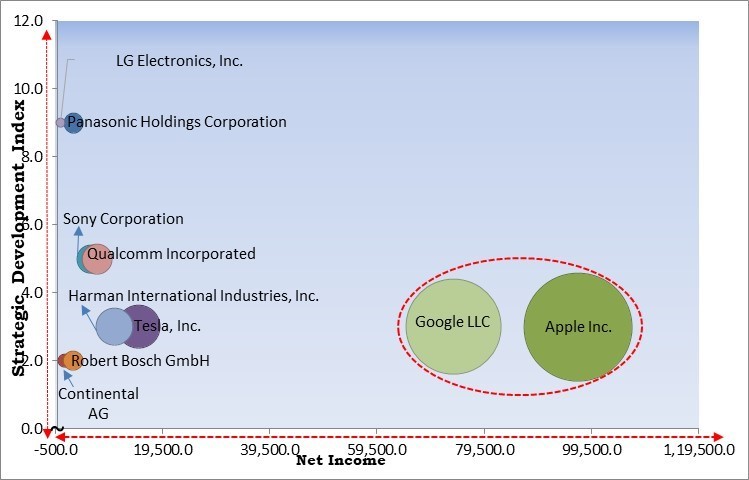
The proliferation of on-demand streaming services has reshaped consumer entertainment consumption habits. As passengers become accustomed to accessing a wide range of content—such as movies, music, and games—on their devices, they expect similar capabilities in their vehicles. This demand for connectivity and content diversity drives automakers to integrate advanced entertainment systems into their models.
Additionally, streaming services such as Netflix, Hulu, Disney+, Spotify, and Apple Music offer a vast array of content, including movies, TV shows, music, podcasts, and audiobooks. This extensive selection appeals to a wide range of consumer preferences and demographics, catering to different tastes and age groups. Many streaming platforms are expanding their libraries to include localized content, which enhances relevance for diverse audiences. Thus, increasing content libraries and streaming services is proposing the growth of the market.
Transitioning from previous generations of mobile technology (such as 4G) to 5G often requires substantial upgrades to existing infrastructure, including base stations, antennas, and transmission lines. This can involve high capital expenditures, particularly for industries with limited budgets. 5G networks require a denser network of small cells to provide adequate coverage, especially in urban and industrial areas. Hence, high infrastructure costs associated with 5G deployment hamper the market's growth.
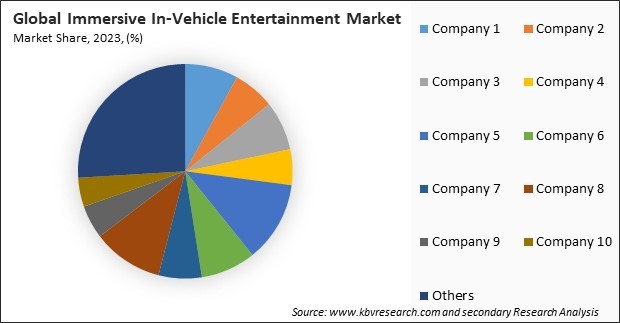
The leading players in the market are competing with diverse innovative offerings to remain competitive in the market. The above illustration shows the percentage of revenue shared by some of the leading companies in the market. The leading players of the market are adopting various strategies in order to cater demand coming from the different industries. The key developmental strategies in the market are Product Launches and Product Expansions.
On the basis of device type, the market is segmented into head-mounted displays (HMDs), in-car displays, wearables, and others. The in-car displays segment recorded 35% revenue share in the market in 2023. In-car displays are integrated into the vehicle’s interior, typically within the dashboard or rear seats, providing passengers easy access to entertainment and information.
Based on vehicle type, the market is segmented into commercial vehicles and passenger vehicles. The commercial vehicles segment witnessed 27% revenue share in the market in 2023. Companies operating in logistics, public transport, and ride-sharing services are increasingly looking to enhance the travel experience for their employees and customers.
By offering, the market is divided into hardware, software, and services. In 2023, the hardware segment registered 59% revenue share in the market. This dominance can be attributed to the essential role that hardware components, such as displays, audio systems, and connectivity devices, play in delivering high-quality entertainment experiences.
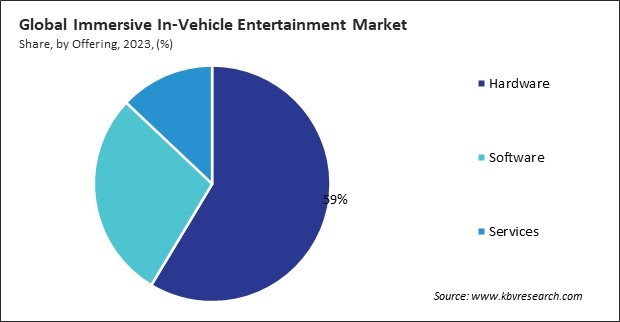
Based on technology, the market is divided into augmented reality (AR), virtual reality (VR), mixed reality (MR), 360-degree video, and others. In 2023, the augmented reality (AR) segment garnered 42% revenue share in the market. AR technology overlays digital information onto the real-world environment, offering passengers an interactive viewing experience.
Based on application, the market is divided into infotainment, navigation assistance, safety & driver assistance, passenger entertainment, and others. The infotainment segment attained 39% revenue share in the market in 2023. This segment’s dominance can be attributed to the growing consumer demand for integrated entertainment solutions that combine audio, video, and information services. Infotainment systems typically include features such as music streaming, podcast access, and smartphone integration, enabling users to enjoy a rich array of content while on the move.
On the basis distribution channel of the market is bifurcated into OEM and aftermarket. The aftermarket segment held 33% revenue share in the market in 2023. Aftermarket solutions allow consumers to upgrade their vehicles with enhanced entertainment features.
Free Valuable Insights: Global Immersive In-Vehicle Entertainment Market size to reach USD 11.6 Billion by 2031
Region-wise, the market is analyzed across North America, Europe, Asia Pacific, and LAMEA. The Asia Pacific region generated 29% revenue share in 2023. Rapid economic growth, increasing disposable incomes, and a burgeoning middle class in countries like China and India have increased demand for advanced vehicle technologies, including immersive entertainment systems.
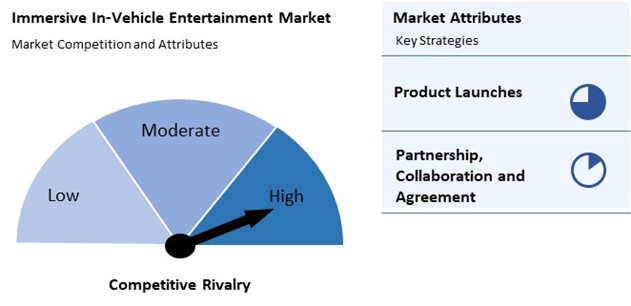
The immersive in-vehicle entertainment market is highly competitive, driven by advancements in augmented reality (AR), virtual reality (VR), and AI. Key players focus on creating seamless, interactive experiences with features like surround sound, head-up displays, and personalized content. Partnerships with tech companies and automakers enhance integration, while a focus on 5G connectivity boosts streaming capabilities. Market competition revolves around offering differentiated experiences, enhanced safety, and minimal driver distraction, aiming to meet rising consumer demand for luxury and innovative in-car entertainment solutions.
| Report Attribute | Details |
|---|---|
| Market size value in 2023 | USD 1.8 Billion |
| Market size forecast in 2031 | USD 11.6 Billion |
| Base Year | 2023 |
| Historical Period | 2020 to 2022 |
| Forecast Period | 2024 to 2031 |
| Revenue Growth Rate | CAGR of 27.1% from 2024 to 2031 |
| Number of Pages | 412 |
| Tables | 642 |
| Report coverage | Market Trends, Revenue Estimation and Forecast, Segmentation Analysis, Regional and Country Breakdown, Competitive Landscape, Market Share Analysis, Porter’s 5 Forces Analysis, Company Profiling, Companies Strategic Developments, SWOT Analysis, Winning Imperatives |
| Segments covered | Vehicle Type, Offering, Device Type, Application, Technology, Distribution Channel, Region |
| Country scope |
|
| Companies Included | Tesla, Inc., Sony Corporation, Panasonic Holdings Corporation, Continental AG, Harman International Industries, Inc. (Samsung Electronics Co., Ltd.), Robert Bosch GmbH, LG Electronics, Inc. (LG Corporation), Qualcomm Incorporated (Qualcomm Technologies, Inc.), Apple Inc., and Google LLC |
By Vehicle Type
By Offering
By Device Type
By Application
By Technology
By Distribution Channel
By Geography
This Market size is expected to reach $11.6 billion by 2031.
Increasing consumer demand for enhanced in-car experiences are driving the Market in coming years, however, High initial costs of advanced in-vehicle entertainment systems restraints the growth of the Market.
Tesla, Inc., Sony Corporation, Panasonic Holdings Corporation, Continental AG, Harman International Industries, Inc. (Samsung Electronics Co., Ltd.), Robert Bosch GmbH, LG Electronics, Inc. (LG Corporation), Qualcomm Incorporated (Qualcomm Technologies, Inc.), Apple Inc., and Google LLC
The expected CAGR of this Market is 27.1% from 2024 to 2031.
The Passenger Vehicles segment is leading the Market by Vehicle Type in 2023; thereby, achieving a market value of $8.3 billion by 2031.
The North America region dominated the Market by Region in 2023, and would continue to be a dominant market till 2031; thereby, achieving a market value of $3.7 billion by 2031.
Our team of dedicated experts can provide you with attractive expansion opportunities for your business.
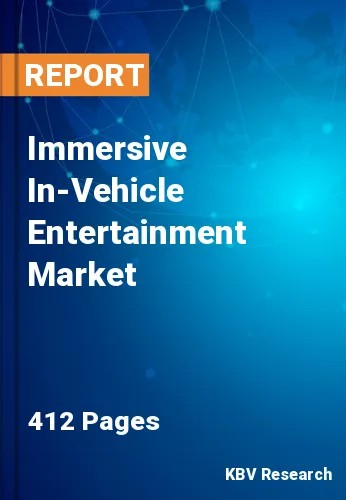
 Drivers
Drivers
 Restraints
Restraints
 Opportunities
Opportunities
 Challenges
Challenges
